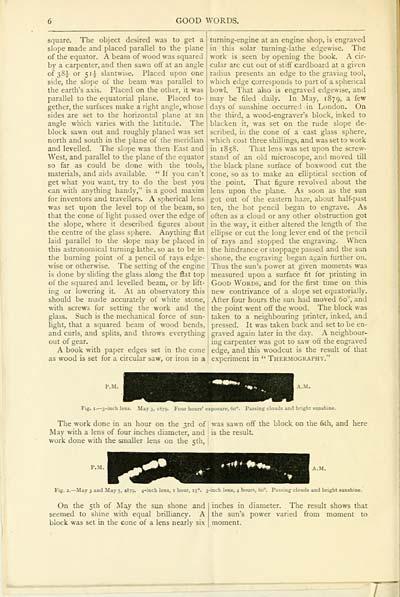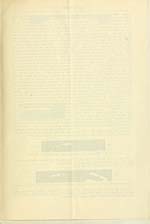Download files
Complete book:
Individual page:
Thumbnail gallery: Grid view | List view

GOOD WORDS.
square. The object desired was to get a
slope made and placed parallel to the plane
of the equator. A beam of wood was squared
by a carpenter, and then sawn off at an angle
of 38^ or 5ii slantwise. Placed upon one
side, the slope of the beam was parallel to
the earth's axis. Placed on the other, it was
parallel to the equatorial plane. Placed to-
gether, the surfaces make a right angle, whose
sides are set to the horizontal plane at an
angle which varies with the latitude. The
block sawn out and roughly planed was set
north and south in the plane of the meridian
and levelled. The slope was then East and
West, and parallel to the plane of the equator
so far as could be done with the tools,
materials, and aids available. " If you can't
get what you want, try to do the best you
can with anything handy," is a good maxim
for inventors and travellers. A spherical lens
was set upon the level top of the beam, so
that the cone of light passed over the edge of
the slope, where it described figures about
the centre of the glass sphere. Anything flat
laid parallel to the slope may be placed in
this astronomical turning-lathe, so as to be in
the burning point of a pencil of rays edge-
wise or otherwise. The setting of the engine
is done by sliding the glass along the fiat top
of the squared and levelled beam, or by lift-
ing or lowering it. At an observatory this
should be made accurately of white stone,
with screws for setting the work and the
glass. Such is the mechanical force of sun-
light, that a squared beam of wood bends,
and curls, and splits, and throws everything
out of gear.
A book with paper edges set in the cone
as wood is set for a circular saw, or iron in a
turning-engine at an engine shop, is engraved
in this solar turning-lathe edgewise. The
work is seen by opening the book. A cir-
cular arc cut out of stiff cardboard at a given
radius presents an edge to the graving tool,
which edge corresponds to part of a spherical
bowl. That also is engraved edgewise, and
may be filed daily. In May, 1879, ^ '^^
days of sunshine occurred in London. On
the third, a wood-engraver's block, inked to
blacken it, was set on the rude slope de-
scribed, ir. the cone of a cast glass sphere,
which cost three shillings, and was set to work
in 1858. That lens was set upon the screw-
stand of an old microscope, and moved till
the black plane surface of boxwood cut the
cone, so as to make an elliptical section of
the point. That figure revolved about the
lens upon the plane. As soon as the sun
got out of the eastern haze, about half-past
ten, the hot pencil began to engrave. As
often as a cloud or any other obstruction got
in the way, it either altered the length of the
ellipse or cut the long lever end of the jjencil
of rays and stopped the engraving. When
the hindrance or stoppage passed and the sun
shone, the engraving began again further on.
Thus the sun's power at given moments was
measured upon a surface fit for printing in
Good Words, and for the first time on this
new contrivance of a slope set equatorially.
After four hours the sun had moved 60", and
the point went oft' the wood. The block v/as
taken to a neighbouring printer, inked, and
pressed. It was taken back and set to be en-
graved again later in the day. A neighbour-
ing carpenter was got to saw off the engraved
edge, and this woodcut is the result of that
experiment in " Thermography.''
Fig. 1.^3-inch lens.
The work done in an hour on the 3rd of was sawn off the block on the 6th, and here
May with a lens of four inches diameter, and is the result,
work done with the smaller lens on the 5 th,
Fig. 2.— May 3 and May 5, 1^79. 4-inch lens, i hour, 15°. 3-inch lens, 4 hours, 60°. Passio;; clouds and bright sunshine.
On the 5th of May the sun shone and I inches in diameter. The result shows that
seemed to shine with equal brilliancy. A the sun's power varied from moment to
block was set in the cone of a lens nearly six | moment.
square. The object desired was to get a
slope made and placed parallel to the plane
of the equator. A beam of wood was squared
by a carpenter, and then sawn off at an angle
of 38^ or 5ii slantwise. Placed upon one
side, the slope of the beam was parallel to
the earth's axis. Placed on the other, it was
parallel to the equatorial plane. Placed to-
gether, the surfaces make a right angle, whose
sides are set to the horizontal plane at an
angle which varies with the latitude. The
block sawn out and roughly planed was set
north and south in the plane of the meridian
and levelled. The slope was then East and
West, and parallel to the plane of the equator
so far as could be done with the tools,
materials, and aids available. " If you can't
get what you want, try to do the best you
can with anything handy," is a good maxim
for inventors and travellers. A spherical lens
was set upon the level top of the beam, so
that the cone of light passed over the edge of
the slope, where it described figures about
the centre of the glass sphere. Anything flat
laid parallel to the slope may be placed in
this astronomical turning-lathe, so as to be in
the burning point of a pencil of rays edge-
wise or otherwise. The setting of the engine
is done by sliding the glass along the fiat top
of the squared and levelled beam, or by lift-
ing or lowering it. At an observatory this
should be made accurately of white stone,
with screws for setting the work and the
glass. Such is the mechanical force of sun-
light, that a squared beam of wood bends,
and curls, and splits, and throws everything
out of gear.
A book with paper edges set in the cone
as wood is set for a circular saw, or iron in a
turning-engine at an engine shop, is engraved
in this solar turning-lathe edgewise. The
work is seen by opening the book. A cir-
cular arc cut out of stiff cardboard at a given
radius presents an edge to the graving tool,
which edge corresponds to part of a spherical
bowl. That also is engraved edgewise, and
may be filed daily. In May, 1879, ^ '^^
days of sunshine occurred in London. On
the third, a wood-engraver's block, inked to
blacken it, was set on the rude slope de-
scribed, ir. the cone of a cast glass sphere,
which cost three shillings, and was set to work
in 1858. That lens was set upon the screw-
stand of an old microscope, and moved till
the black plane surface of boxwood cut the
cone, so as to make an elliptical section of
the point. That figure revolved about the
lens upon the plane. As soon as the sun
got out of the eastern haze, about half-past
ten, the hot pencil began to engrave. As
often as a cloud or any other obstruction got
in the way, it either altered the length of the
ellipse or cut the long lever end of the jjencil
of rays and stopped the engraving. When
the hindrance or stoppage passed and the sun
shone, the engraving began again further on.
Thus the sun's power at given moments was
measured upon a surface fit for printing in
Good Words, and for the first time on this
new contrivance of a slope set equatorially.
After four hours the sun had moved 60", and
the point went oft' the wood. The block v/as
taken to a neighbouring printer, inked, and
pressed. It was taken back and set to be en-
graved again later in the day. A neighbour-
ing carpenter was got to saw off the engraved
edge, and this woodcut is the result of that
experiment in " Thermography.''
Fig. 1.^3-inch lens.
The work done in an hour on the 3rd of was sawn off the block on the 6th, and here
May with a lens of four inches diameter, and is the result,
work done with the smaller lens on the 5 th,
Fig. 2.— May 3 and May 5, 1^79. 4-inch lens, i hour, 15°. 3-inch lens, 4 hours, 60°. Passio;; clouds and bright sunshine.
On the 5th of May the sun shone and I inches in diameter. The result shows that
seemed to shine with equal brilliancy. A the sun's power varied from moment to
block was set in the cone of a lens nearly six | moment.
Set display mode to: Large image | Transcription
Images and transcriptions on this page, including medium image downloads, may be used under the Creative Commons Attribution 4.0 International Licence unless otherwise stated. ![]()
| Early Gaelic Book Collections > J. F. Campbell Collection > Campbell's registering sun-dial > (36) |
|---|
| Permanent URL | https://digital.nls.uk/78411797 |
|---|
| Description | Volumes from a collection of 610 books rich in Highland folklore, Ossianic literature and other Celtic subjects. Many of the books annotated by John Francis Campbell of Islay, who assembled the collection. |
|---|
| Description | Selected items from five 'Special and Named Printed Collections'. Includes books in Gaelic and other Celtic languages, works about the Gaels, their languages, literature, culture and history. |
|---|

